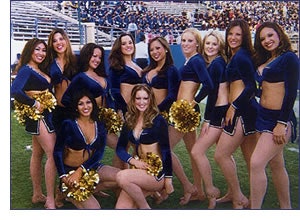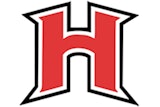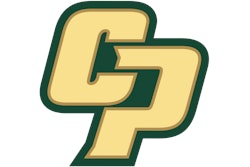A heated exchange at San Jose State sparks debate over appropriate in-game entertainment.
 Photo of SJSU Dance Team
Photo of SJSU Dance Team
To be specific, it wasn't the actual game-in which the University of Nevada rallied to beat San Jose State, 73-69, in the March 5 regular-season finale for both teams-but rather a break in the action that sparked debate among Internet bloggers and cable news talking heads for weeks.
In the span of a 90-second TV timeout, during the San Jose State dance team's routine to the song "Move Somethin' " by hip-hop artist LL Cool J, a 74-year-old booster admittedly "came unglued," shouting "Trash!" from his seat high in the stands and imploring the eight women who comprise the team to leave the floor. "It was vulgar," Ray Silva, the former president of SJSU's alumni association and a major fundraiser for Spartan athletics, later told The Mercury News of San Jose. "It was like a burlesque, with bumps and grinds."
Immediately after the game, 20-year-old dance team member Tarah DiNardo performed one last move. She approached Silva and defended the routine during an animated confrontation caught on video by a dance team parent. The exchange became so heated that SJSU senior associate athletic director and chief operations officer John Glass, whose job includes fundraising supervision, attempted to restrain DiNardo by grabbing her arm with enough force to bruise it, according to a subsequent university police investigation. Still, the Santa Clara County district attorney's office decided not to press DiNardo's battery charges against Glass, who as of this writing remained employed by the university.
But the legal maneuvering didn't end there. DiNardo's father retained an attorney and in late April filed a civil suit against San Jose State. "I'm trying to send a message to the school: Nobody touches nobody," says the elder DiNardo. "They put a dirty-dancing spin on it, but the bottom line is that instead of sticking up for the student, they stuck up for the alum, the money man." By then, more than a month after the incident, the San Jose State athletic department had suspended the dance team for its final two scheduled appearances of the academic year. The reason reportedly given was breach of contract-that a proper chain of command wasn't followed when Tarah DiNardo approached Silva directly. (According to DiNardo, team members signed a conduct contract before the start of football season, but not before basketball season, as was the practice in the past.) "We concluded that the team's infrastructure was inadequate and inconsistent with our mission," said associate athletic director Mark Harlan in a written statement dated April 6. "We want a dance team that represents San Jose State University at the highest possible standard and be [sic] a noteworthy component in a successful Division I-A program."
After the court system took an initial pass on the DiNardo case, the public was left to judge what constitutes appropriate in-game entertainment at collegiate athletic events. A May 1 Google search of the commonly used headline "San Jose State Suspends Sexy Dance Team" pulled some 560 articles. Bloggers weighed in with reactions ranging from the crass to the constructive, with serious thought given to defining what constitutes a family-friendly environment at sporting events and whether dance team members should be viewed as role models.
Some came to the dancers' defense. "The reaction you received from the older gentleman and the university official was uncalled for, disrespectful and rude," wrote a University of Oregon student and high school dance coach to SJSU's Spartan Daily student newspaper. "The routine I saw was clearly not scandalous enough to warrant a reaction, much less that one." Added the mother of an SJSU graduate, "In my mind, Mr. Silva incited the reaction he received. Heckling in a disruptive manner should not be tolerated, no matter how deep the pockets of the heckler."
However, when a New Mexico TV station asked the online poll question, "Have cheerleading and dance routines become too sexy?" 65 percent of 25,000 respondents answered, "Yes, the routines are inappropriate," while 35 percent said, "No, they're just giving people what they want." In fact, DiNardo claims that throughout the dance team's brief two-year history, SJSU officials have wanted "more makeup, more hair and sexier uniforms" in the interest of ticket sales-a charge the current athletics administration, which took office December 20, denies. "That doesn't strike me as anything we'd want," Harlan told The Mercury News. (It should be noted that, unlike Harlan, Glass is a holdover from the previous regime.)
SJSU administrators sought an NFL-style dance team, DiNardo adds, and their choice of head coach reflected that. Until this December, the team was led by Jenise Mills, a former cheerleader for the NFL's San Francisco 49ers and later the AFL's San Jose SaberCats. Mills, who married and moved to Modesto, turned the team over to another former 49ers cheerleader, Michelle LaHerran, who wasn't formally hired or paid by the university, according to DiNardo, who adds LaHerran wasn't even present at the March 5 game.
According to DiNardo, Mills had made SJSU dance team members sign a "looks contract," outlining such appearance parameters as weight, hair length and makeup usage-all with the knowledge of athletic department officials. Cleavage was even critiqued and adjusted accordingly with bra inserts, according to DiNardo. Team members who failed to comply with Mills' mandates were not allowed to perform.
DiNardo says she doesn't know if such contracts are commonplace at the college level, but San Jose State certainly isn't alone in sexing up its game-day atmosphere. This past basketball season, Syracuse University's dance team performed a routine to a song that includes the lyric, "Keep the skin tight and the booty in the air"-albeit without incident. "In our Lenny Kravitz routine there's a little booty shake that goes with the music," head coach Nicolette Balducci told the Daily Orange student newspaper. "I can't say we totally avoid it."
"Move Somethin' " by LL Cool J, a song DiNardo says her team used dozens of times dating back to last football season, offers similarly graphic imagery. A sampling of the lyrics heard in the arena March 5: "Push it out girl, arch your back / Them 17's is fittin' like bubble wrap / Uhh, plus they low on your hips / You there, let me grab / That thing you do keep me brick / 50 told you bout the 'Magic Stick' / C'mon, lean on me / I'm in love with this scenery."
It's a song that Laura Grindstaff, a University of California-Davis associate professor who is researching a forthcoming book on cheerleading, has heard played while high school squads conduct warm-ups. She adds that some high school cheerleading coaches fear that the traditions of cheerleading may be giving way to something less wholesome. "A lot of them complain that high school cheerleading teams aren't really cheerleading teams anymore. They're becoming more like dance teams, because all they want to do is dance, and the dancing is really nasty, and by nasty, of course, I mean sexual," Grindstaff says. "I don't think it's unique to San Jose State. I think it's pretty much a widespread phenomenon." At least one lawmaker fears the situation is getting out of control. Texas Rep. Al Edwards (D-Houston) has introduced legislation that would restrict "sexually suggestive" performances by dance teams, drill teams and cheerleaders at high school athletic events or competitions. A squad that performs an inappropriate routine could be banned from performing for the rest of the school year, and the district or campus could be fined. Having passed the Texas House of Representatives by a 65-56 vote May 3, the bill awaited debate in the state Senate as of this writing.
Meanwhile, the spirit industry arguably is steering cheerleading squads and dance teams down a raunchier road these days. DiNardo says that the dance moves used during "Move Somethin' " were lifted directly from United Spirit Association camps. The Universal Dance Association, which hosts an annual collegiate dance team competition, has an entire championship category devoted to hip-hop. And suggestive music and sexual moves represent only pieces of the puzzle. The University of Cincinnati, UDA's two-time defending Division I-A hip-hop champion, has performed in uniforms seemingly perpetuating the Catholic schoolgirl fantasy, with knee-high white socks, plaid pleated skirts, crop tops and baseball caps. "There has always been an element to all-girl dance teams that's been about sexuality, performance, exhibition and entertainment," Grindstaff says. "Being sexy and being entertaining-those two things are very enmeshed with one another, and that goes back a really long time. I don't know that you could draw a line and say, 'Well, now it's just gone too far.' It's a different context now. It's a different climate."
Adds Mary Ellen Hanson, a University of New Mexico associate professor and author of the 1996 book "Go, Fight, Win: Cheerleading in American Culture," of Silva's apparent outrage, "I'm thinking, where has he been? What television, movies and commercials has he been watching? Is he writing to his local TV stations about the beer commercials they run?" (Silva declined AB's request for an interview.) "You don't go to a hockey game and then complain about the fights," DiNardo says in her own defense. "When you go to a college basketball game, you know there are going to be cheerleaders there. We're not trying to stimulate. We're just dancing."
Dance teams, even those under athletic department auspices, often serve as their own decency police. Five years ago, Syracuse dancers-who at that time counted Balducci among them-decided to scrap a sexually suggestive routine element involving chairs. Today, performance standards at Syracuse are outlined in a team handbook. "We look at ourselves as ambassadors" of the university, Balducci told the Daily Orange. "We're very visible in what we do. We have to carry ourselves professionally." That said, San Jose State dancers have heeded complaints in the past-from administrators after a song used during a pep rally routine last summer included a four-letter word, as well as from a female donor offended by uniforms that revealed team members' cleavage and midsections. The dance team now uses only safe-for-radio versions of songs (though no formal administrative screening process is in place) and wears more discreet outfits.
It remains unclear whether SJSU officials were caught completely unawares by the March 5 routine to "Move Somethin'," since they are standing only by their two released statements on the subject. In the statement dated April 6, Harlan said, "We will take a much more active role supervising and managing the dance team. We will produce a defined set of guidelines, parameters and expectations. Next year's team will have dance instruction that will enhance their skills, newly designed uniforms and a wider range of entertaining musical selections for our spectators."
Next year's team, it turns out, may not include DiNardo. While every other member has been contacted by the university about the team's reinstatement-even women who will have graduated by fall-DiNardo reports receiving no such call.





































